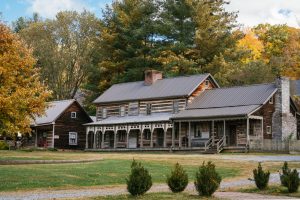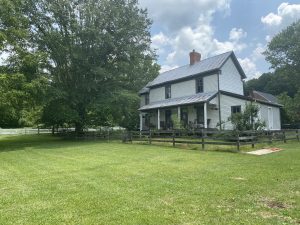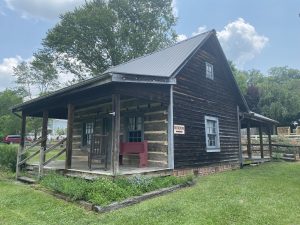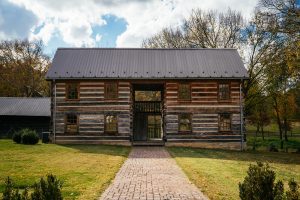(south side of Orebank Road)
The structures listed here are not part of the restored farmstead, though some are original to the property, having been built after the Civil War. Others, like Roseland and the Gaines-Anderson House (Burow Museum), were moved or reconstructed on the site.

This large triple log pen structure originally stood on Shipp Street (near Eastman off of Wilcox Drive). It was home to the Bachman, Steadman, and Shipp families before it was donated to Exchange Place in the 1990s and moved to its current location in three pieces.
The oldest portion dates to the late 18th century and is a single pen cabin with a loft. Over time, the house was expanded to include four more rooms and a dog trot. In the late 19th century, it was covered with clapboard, and the porch with intricate gingerbread woodwork was added.
At one time, the house was surrounded by rose gardens, which inspired the name “Roseland.” Currently, it serves as a community center for Exchange Place and meeting place for the Overmountain Weaver’s Guild.
Roseland, around 1900
Roseland is also home to Exchange Place’s resident ghost—Aunt El. Amanda Ellen Steadman (“Aunt El”) was born in 1860 and lived most of her life at Roseland. She was an expert weaver and quilter and was very fond of children, though she never had any of her own. Aunt El died in 1939 and was buried in the family cemetery on a ridge overlooking the original site of Roseland, but her spirit supposedly never left her home. Steadman family members recalled strange occurrences around the house after Aunt El passed, including one of her quilts that would never stay on the bed.
Even after Roseland was moved to the Exchange Place farm, Aunt El’s spirit remained in the building. Volunteers often report seeing lights on in the attic at night or doors closing on their own. Overall, though, Aunt El’s spirit is a comforting, albeit sometimes mischievous, companion.

The white clapboard Cadwallader House serves as a residence for the Exchange Place caretakers. It was named after Rick and Sue Cadwallader, who served as caretakers from 1985-2010. Originally, the structure was the circa 1900 “kitchen wing” addition on the back of the Main House. It was moved to its current location in the 1980s.
Main House, circa 1970 showing back-ell “kitchen wing” (now the Cadwallader House)

The Museum Shop was constructed from logs from several historic structures. It is open during festivals and special events.
This large barn, built around 1925, is of frame construction with pegged beams. It features a quilt square of the “Cross and Crown” pattern from a Preston family quilt and is a part of the regional Quilt Trail. The corncrib beside it originally stood where Roseland is now.

The Burow Museum houses the Exchange Place archives and serves as an exhibit space to teach about Exchange Place and regional history. The museum honors long-time volunteers Dick and Suzanne Burow, who spearheaded the purchasing of additional acreage and the designation of Exchange Place as a living history farm.
Many of the logs used for the building came from the Gaines-Anderson House, originally located on Stone Drive in the Arcadia community. The oldest part of the house was built in 1796 by Ambrose Gaines, a relative of John Gaines. In the 1940s, the whole structure was moved several hundred yards during the construction of Stone Drive. In 2015, it was dismantled and moved to Exchange Place. It has been reconstructed in the “dog-trot” style with a breezeway between the two pens.
Click here to see Current Exhibits.
Gaines-Anderson House in its original location on Stone Drive
The mission of Exchange Place Living History Farm is to preserve and interpret the heritage of mid-19th century farm life in Northeast Tennessee. A private, non-profit organization, Exchange Place is maintained and operated primarily by volunteers and is supported by donations, fundraisers, memberships, and grants.

Exchange Place
4812 Orebank Rd,
Kingsport, TN 37664
423-288-6071